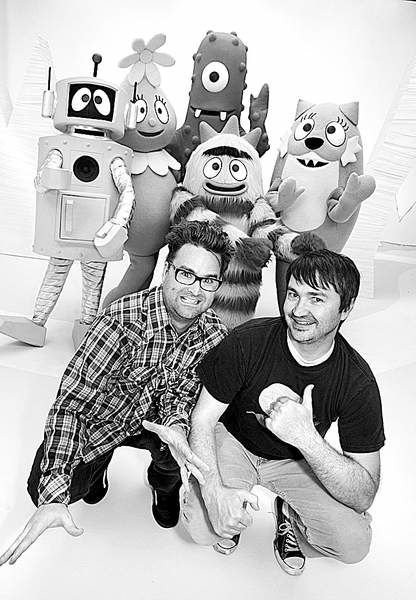‘Yo Gabba Gabba’ draws viewers with sincerity
Published 4:00 am Friday, November 12, 2010

- Christian Jacobs, left, and Scott Schultz are co-creators of Nickelodeon's “Yo Gabba Gabba,” aimed at preschoolers.
Barney’s got nothing on Muno.
Barney, the big purple dinosaur, was all the rage with toddlers in the ’90s, but few adults cottoned to his bouncy, mindless ways.
Enter Muno. The one-eyed red monster, one of the stars of Nick Jr.’s colorful, surreal “Yo Gabba Gabba,” boasts devotees such as Jack Black, Elijah Wood, Tony Hawk and the Roots. How’s that for a fan base?
“Yo Gabba Gabba” is the hippest kids show around, drawing trendy indie bands and all manner of celebrities with an adventurous, skewed mix of retro graphics, musical dance numbers and educational content.
It’s the latest in a procession of cool kids shows that have engaged teens and parents as much as the preschool set, cleverly mixing entertainment with trendy visuals and a bona fide respect for their target audience.
It’s also big business. Nickelodeon’s similarly hip, adult-friendly “SpongeBob SquarePants” has spawned its own media franchise over the years with albums, a film, merchandising and lucrative syndication deals. It held seven of the Top 25 basic-cable ratings spots last week.
“Yo Gabba Gabba” is following suit with international tours, DVDs, two albums and enough critical love (Emmy nominations, back-to-back awards from the Television Critics Association) to ensure its existence well into the future.
And when “Yo Gabba Gabba! Live! There’s a Party in My City!” visits one of the 60 cities on its North American tour, don’t be surprised if adults are bobbing their heads and singing along as much as their tiny counterparts.
There are multiple schools of thought when it comes to creating children’s programming.
Some take the strategic approach, identifying needs and attempting to fulfill them with a targeted mix of education and entertainment. These ideas are the products of network executives, marketing professionals and people with advanced degrees in childhood education and psychology.
Others, like the creators of “Yo Gabba Gabba,” are simply sick of what’s out there and — in the absence of alternatives — create their own versions of what they want to see. This is the essence of punk rock.
“The show itself comes from a very pure place, which is why it’s translated so well,” said Mike Lubo, tour producer for “Yo Gabba Gabba’s” stage show and a veteran concert promoter. “If (creators) Christian (Jacobs) and Scott (Schultz) had to do another half hour of what was currently being offered on TV for their kids, they were going to poke their eyes out. So it was kind of out of self-defense.”
Jacobs and Schultz grew up producing skateboarding videos in Southern California; Jacobs is also a member of the costume-loving ska band the Aquabats, while Schultz is in the band Majestic. Their tone has always been decidedly young and connected to the underground arts world.
They began filming “Yo Gabba Gabba” in their garage and promoting it via DVDs and the Internet, but it didn’t take off until “Napoleon Dynamite” director Jared Hess became a champion, leading to the Nickelodeon deal.
Now in its third season, “Yo Gabba Gabba” has welcomed musical acts such as rapper Biz Markie (a favorite of the show), Weezer, The Killers, The Flaming Lips, The Shins and MGMT, as well as actress Amy Sedaris, bad-boy chef Anthony Bourdain and comedian Sarah Silverman.
In other words, to have appeared on the show — or performed on its live tour, as such folks as Snoop Dogg, Devendra Banhart and Talib Kweli have — is a badge of coolness. But the creators won’t take just anyone.
“We’re not trying to get the most popular band we can or the most popular celebrity. That was never the idea,” said co-creator Schultz. “Bands really have to jump through hoops and record a brand-new kids song and do a lot of these things, so you can tell the bands who are actually on the show want to be on the show.”
Most kids entertainment is designed to appeal to broad sensibilities, since kids’ tastes are highly fluid. That’s why kids entertainment has strived to be loose, relatable and fun.
But the shows that have risen above the nostalgic appeal and easy humor of “The Howdy Doody Show” and “The Mickey Mouse Club” offer something for adults, too.
Popular, groundbreaking PBS shows of the 1970s, such as “Sesame Street” (which featured Jim Henson’s similarly adult-friendly Muppets) and “The Electric Company,” not only welcomed the hottest comedians and musicians of the time, they cemented the blend of live skits, animation and music that underpins nearly all kids’ programming today.
And these days, “multimedia” is the word for staying ahead of the curve.
“You look at what makes a classic entertainment property, period, and that also applies to children: great characters, a great story and a real societal need,” said Lesli Rotenberg, senior vice president of Children’s Media for PBS. “But it’s much, much more challenging to develop a children’s property today than ever before because it’s not a linear television program that will live in one dimension only.”
These days, characters exist not just on television but websites, video games and mobile devices, allowing their creators (and their financial beneficiaries) to track their progress and the level of interactivity audiences have with them.
Rotenberg knows this well. PBSkids.org was the No. 1 kids site for free videos streamed in September, according to comScore Video Metrix, with nearly 88 million views of its 3,800 episodes and video clips.
“It’s a great opportunity to see if (kids) are actually picking up the things we try to teach them,” she said. “Now you can take it with you with your iPad or iPhone. You can call up these characters and interact with them on a touch screen, so it’s great for little fingers.”
‘Yo Gabba Gabba’
When: 6 a.m. daily
Where: Nick Jr.






